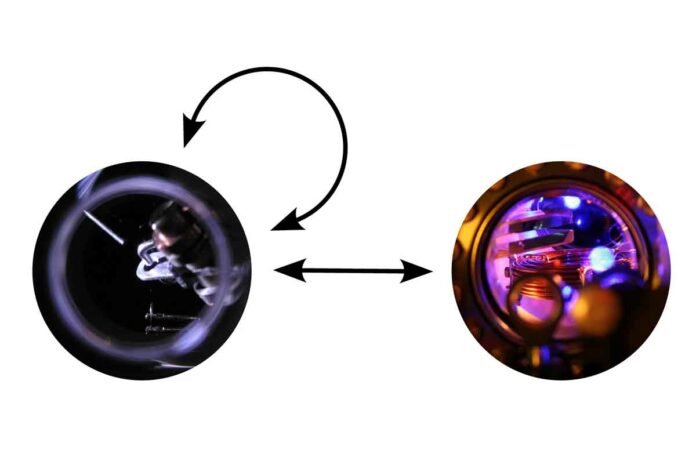Scientists at the Physikalisch-Technische Bundesanstalt (PTB) have conducted a groundbreaking study to explore the potential interaction between dark matter and photons.
Within the Collaborative Research Center DQ-mat and the Cluster of Excellence Quantum Frontiers, researchers compared two types of optical atomic clocks, providing the most accurate search for the interaction of ultralight dark matter with photons to date.
The existence of “dark matter,” a mysterious form of matter that constitutes over 80% of the universe, has been inferred through astronomical observations.
However, its interaction with visible matter, if any, remains largely elusive, with gravity being the only known mode of interaction.
Dark matter’s interaction with photons, the elementary particles that compose light, has yet to be established, giving rise to the enigmatic name “dark” matter.
In a compelling theoretical approach, scientists propose that dark matter may consist of ultralight particles that exhibit more wave-like characteristics than discrete particles.
These ultralight particles could potentially exhibit weak interactions with photons, leading to minuscule oscillations of the fine-structure constant.
The fine-structure constant is a natural constant that quantifies the strength of the electromagnetic interaction.
It governs atomic energy scales and influences the transition frequencies utilized as references in atomic clocks.
By comparing the sensitivity of different atomic clocks to potential variations in the fine-structure constant, researchers at PTB sought to detect ultralight dark matter.
In a months-long experiment, a highly sensitive atomic clock was compared with two other atomic clocks possessing lower sensitivities.
The data collected were meticulously analyzed for oscillations that would serve as evidence of ultralight dark matter.
Despite extensive scrutiny, no significant oscillations were detected, keeping dark matter shrouded in mystery and impervious to closer examination.
Nevertheless, this absence of a signal allowed scientists to establish new experimental upper limits on the potential coupling strength between ultralight matter and photons, surpassing previous limits by an impressive order of magnitude.
Simultaneously, researchers explored whether the fine-structure constant undergoes gradual changes over time, such as slow increments or decrements.
However, the data analysis failed to detect any such variations. These findings further reinforced the notion that the constant remains unchanged even over extended periods.
This study presented a novel approach to clock comparisons by integrating two atomic clocks into a single experimental setup.
By utilizing two different transition frequencies of a single trapped ion, scientists achieved greater compactness and robustness in optical frequency comparisons.
This advancement paves the way for future investigations into dark matter, including potential searches in space.
The results of this groundbreaking research have been published in the latest edition of the prestigious journal Physical Review Letters, garnering considerable attention within the scientific community.
While the search for dark matter’s true nature and its interaction with conventional matter continues, these significant advancements in optical atomic clocks bring us closer to unraveling the mysteries of the universe.
With each new discovery, scientists edge nearer to comprehending the enigmatic realm of dark matter and its profound implications for our understanding of the cosmos.
Frequently Asked Questions (FAQ)
Dark matter is a mysterious form of matter that constitutes over 80% of the universe. It does not interact with light and other forms of electromagnetic radiation, hence the name “dark” matter. Its existence has been inferred through astronomical observations, primarily through its gravitational effects on visible matter.
The interaction between dark matter and photons is currently unknown. Dark matter is believed to interact only through gravity with visible matter. Scientists are conducting research to investigate possible interactions, including the search for oscillations and couplings between dark matter and photons.
Optical atomic clocks are extremely precise timekeeping devices that utilize the oscillations of atoms as a basis for measuring time. They operate in the optical frequency range, which is much higher than traditional atomic clocks. Optical atomic clocks offer higher accuracy and are essential for various scientific studies, including the search for dark matter interactions.
Scientists compare the sensitivities of different optical atomic clocks to potential variations in the fine-structure constant, which is related to the strength of the electromagnetic interaction. By searching for oscillations and changes in the constant, researchers aim to detect possible interactions between dark matter and photons.
The study conducted by scientists at the PTB compared two types of optical atomic clocks to search for interactions between ultralight dark matter and photons. While no evidence of such interactions was found, the research significantly improved the detection limits for a possible coupling. The study also indicated that the fine-structure constant remains constant over long periods of time.
Understanding dark matter and its interactions is crucial for comprehending the fundamental nature of the universe. It can provide insights into the structure and evolution of galaxies, the formation of large-scale cosmic structures, and the overall composition of the universe. Unraveling the mysteries of dark matter may revolutionize our understanding of physics and cosmology.

